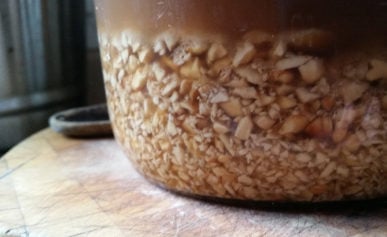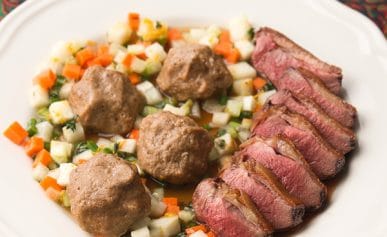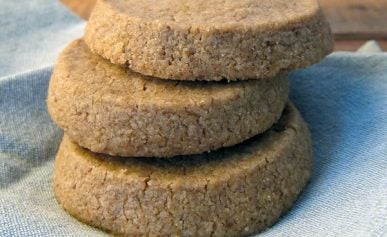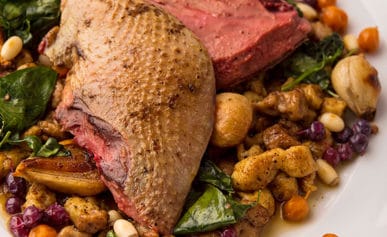As an Amazon Associate I earn from qualifying purchases.
Yes, you can eat acorns, and all acorns are edible — it’s just that most need special processing. Here’s how to go about it.

If you haven’t read my other acorn posts, Acorns and the Forager’s Dilemma is an introduction to the use of acorns; the Forager’s Dilemma is, in a word, starch. Starch (carbohydrates) is the toughest thing to gather, and is a primary reason why humans settled down 10,000 years ago to grow grain.
Next I wrote about how various world cultures have traditionally used acorns, cultures ranging from Korea to Japan to the Native Americans, Europeans and North Africans.
Let me say loud and clear that you can eat acorns and all acorns are edible, at least all species of acorns are. We’ll get into details in a bit.
Basically there are three ways to eat acorns: Eating them as nuts (they are a lot like chestnuts), making acorn flour, or cooking in acorn oil. I have not yet tried to make acorn oil, but that link leads you to my friend Sam Thayer’s website; he sells it.
Collecting Edible Acorns
First you need to get yourself a supply of acorns. Go find some oak trees; they’re the ones with all the acorns that have fallen down around them. I know this sounds condescending and stupid, but oaks come in so many varieties that in autumn this really is the easiest way. It is a bit of a crapshoot, as it is tougher to determine a variety of oak by its acorn than by its the leaf — you can do it, but it is a little harder.
You can gather acorns anytime from September until early spring. I find gathering as the acorns fall is best. Suellen Ocean, who wrote a very useful book Acorns and Eat ’em,says she likes to collect Tanoak acorns in February and March, after many have begun sprouting.
She says acorns with sprouts between 1 to 2 inches long are still good to eat, but discard any acorn meats that have turned green. Ocean says recently sprouted acorns a) have begun to turn their starch into sugar, and b) are foolproof: “If it is sprouted, it’s a good acorn and I haven’t wasted time gathering wormy ones.”
A word on worms. When I first gathered acorns, little did I know that I had gathered scores already infected with the larva of the oak weevil. Nasty little maggoty things, you can tell they are inside your acorn if there is a little hole in the shell. Look for it, discard that acorn and move on. But know that oak weevil larvae bored those holes from the inside out. Like Alien.
It’s helpful to know what kind of oak you are dealing with because acorns from different oaks have different levels of tannins in them; more on that in a bit. If you don’t know your trees, start looking for little green acorns in May. Pick a leaf and compare it to oak leaves online or in a guidebook. Gather acorns and compare them to online images and guidebooks; different oaks bear acorns with different shapes.
With that in mind, remember that not all oaks are created equal, and the fundamental fact to know if you are going to eat acorns is that you are dealing with a wild food, and as such must contend with tremendous variability, both in species and even among individuals of the same species.
Some oaks bear acorns so low in bitter tannins that they can be eaten raw. Legend says that California Indians fought over these trees, which makes some sense because one mature Valley Oak can drop 2,000 pounds of acorns in a really good year. A ton of sweet acorns may well be worth fighting over.
That said, even “sweet” acorns should be leached to remove what tannins exist in them because several studies show that unleached acorns can make you constipated and can harm your teeth. Of all the species I know of, only the imported European cork oak and the Emory oak of the Sonoran Desert come close to being “sweet.”
Tannins aren’t the only thing that makes different species of acorn different. UC Riverside Professor David Bainbridge wrote in a 1986 academic paper that depending on species, acorns can range in fat content from 1.1 percent to 31.3 percent, protein from 2.3 percent to 8.6 percent, and carbohydrates from 32.7 percent to 89.7 percent. That is a huge range!
What does it mean? It means that in the kitchen you treat acorns from different species very, very differently. A fatty acorn will make a meal, like ground almonds. A carb-rich acorn — like Valley Oak acorns — makes a drier flour, more like chestnut or chickpea flour (acorns lack gluten and so will not rise.)

Differences in Various Oaks
Here’s a general breakdown:
‘Sweetest’ Acorns, meaning lowest in tannin: East Coast white oak, the Emory oak of the Southwest, the pin oak of the South, the valley and blue oaks of California, the burr oak of the Midwest, as well as the cork oak and the well-named bellota oak of Europe. To my California readers, know that there are an awful lot of cork oaks and burr oaks planted in towns and cities here, so keep your eyes peeled.
Largest Acorns: Valley oaks are really big, as are East Coast White oaks. Burr oaks are large, too, as is the California Black oak.
Fattiest Acorns: The Eastern red oak acorns I’ve used have a very high oil content, and I’ve read that the Algonquin used red oak acorns for oil. In the West, the champions are both live oaks, the Coastal and the interior live oak, as well as the tanoak and black oak, which is Quercus kellogii.
Shelling Acorns
I found that shelling the acorns is the most onerous part of dealing with them. They have an elastic shell that resists normal nut crackers. I found whacking them with a hammer to be the best way to open up an acorn. Some people use a knife, and I do this with green acorns, but not fully ripe ones.
Best way to whack ’em is to put the flat end (the side that used to have the cap) on a firm surface and rap the pointy end with a hammer, or, with long, tapered acorns like cork oak or Valley oaks, just whack the side.
Acorns are far easier to shell after they’ve dried. If you choose to dry them, do this in wide, shallow pans so they don’t get moldy. Once dried, I’ve worked with two-year-old acorns and they were fine. They will need an overnight soak before grinding, however.
Red oak acorns have a “test,” a skin that doesn’t want to come off, just like a chestnut. Easiest way to deal with this is to freeze your fresh acorns for a week or two before cracking. This will slip the skin off the nut. The skin is bitter, but it’s not that big a deal if you are making flour.
Shell your acorns into water. The meats oxidize, and you will get a lighter-colored flour if you do this. It’s aesthetic, but it matters to me.
Tannins
All acorns should be leached with water to remove bitter tannins, which will a) make your mouth feel and taste like felt, b) make you a bit nauseous, and possibly c) constipate you for days.
Getting those tannins out is the big barrier to cooking with acorns. But it ain’t no biggie. With my valley oak acorns, after shelling I drop the acorn meats directly into my stockpot that was two-thirds full of water. When I fill the pot about a third of the way up with shelled acorns, if I am in a hurry, I bring the pot of water to a boil. The water turns dark. As soon as it boils, pour the water off into the sink and repeat the process.
It requires about five changes of water to get valley oak acorns to taste like chestnuts. I did this all while watching football, and did not miss a snap. Other oaks will require more or fewer changes of water. Choose the “sweetest” acorns on my list above for the least amount of work.
There is a better method, but it takes days. Grind the raw acorns into flour, then mix a ratio of 1 cup of acorn meal to 3 cups water, or more water if you have large containers. Pour this all into a glass jar with a lid and put it in the fridge. Every day you shake the jar, wait 12 hours or more, then pour off the water — and the tannins.
How long? Anywhere from a week to two weeks, depending on how bitter your acorns are. This is a good way to leach acorns without using fuel for boiling water, and you do not denature a particular starch in the acorns that acts a little like the gluten in flour, i.e., it helps the flour stick to itself. I go into the full process of cold leaching acorns here.
If you plan on baking with the acorn flour, use the cold-water leaching method.

Once your acorns are free of tannins, you need to figure out what to do with them. Regardless, you need to dry them first or they will rot. Acorn grits can be patted dry on a tea towel. If it is hot out, lay the acorns out on cookie sheets and dry in the shade. You could also put them in an oven set on “warm.” You can also put the acorns in a dehydrator set on low heat, which is what I do.
You can also freeze your fresh acorn meal. Store dried flour in jars in the fridge. Why the fridge? What fat there is in acorns will go rancid pretty quick if you left the flour at room temperature.
What you can now do to eat acorns is pretty limitless.
My first success was an acorn flour flatbread in the style of an Italian piadina. I also make an acorn flour honey cake, which is really very tasty — almost like gingerbread cake. The flour also makes an excellent pasta dough when mixed with regular flour.
Other Ways To Eat Acorns

Acorn Grits
Acorn grits, which are useful additions to acorn soup, acorn muffins or to eat as a breakfast cereal.
Read More
Wood Duck and Acorn Dumplings
Acorn dumplings, served with wood duck — wood ducks eat acorns, so it seemed fitting.
Read More
Acorn Maple Shortbread Cookies
Acorn cookies, more or less like shortbread. A bit tricky to make, but even if they fall, they are still delicious.
Read More
Acorn Spätzle
Acorn spätzle, little German dumplings that work very well with gluten free acorn flour.
Read MoreI will also substitute about 1/5 of the flour in my homemade flour tortillas with acorn flour, and I also make mean acorn gnocchi.
Use your imagination!









Thanks for all your information. I have 8 acres of Valley Oaks (mature trees) in Central California. Our crop is falling right now. A half of each acorn is about the same size as an almond. They are mature but green when they hit the ground. The fastest way to peel them is in the microwave. Put a counted handful in a Pyrex mixing bowl without any water. They pop like microwave popcorn (same principle). Set on high for 2 or 3 minutes and count the pops until you get close to the number you put in the bowl. Hit the clear button and remove the popped ones (careful–they’re hot!) then continue until the remainder are popped. If you remove the shell while they’re still hot, the skins will peel right off. Valley Oaks aren’t very bitter to begin with and 2 or 3 quick rinses makes them ok to eat. I roast them in a frying pan with butter and garlic salt and snack on them all day long. By using this method, the meats are very tender and easy to eat.
Hi Hank,
I just harvested a bunch of red oak acorns that had just barely started to sprout. Some of the meats are have a little green on them and I was wondering if you know why Suellen says the green ones should be discarded. What is happening to turn them green? Thanks!
Can the tannins be of any kind of use
Michael Courtney: Not that I am aware of.
Yes. Tannin is used for medicine. You get a rag wet with the liquid from the tannin and put on sores on your body. Like bites or scratches. It is supposed to lower your pain levels.
they can be used for medical things as well as for tanning hides.
https://www.outdoorlife.com/blogs/survivalist/survival-skills-5-survival-uses-tannic-acid/
I have a few questions, based off confusing info I found on a farmers’ almanac site. The site said not to use acorns that float when you initially rinse them before shelling & leaching them,but they ALL floated (& few looked rotten on the inside)–a different source said floating acorns are just not ready to sprout yet, so I used them anyway. Is that safe? Also, is it ok to use acorns that has slightly green shells? Finally, I’m in Seattle so it’s extremely humid and my oven’s lowest temp is 275°F, so I’m trying to be creative about drying them for flour. Any suggestions? (I know now I should have ground tgrm before leaching but the other site suggested the opposite order).
Christina: I never use any nut that floats. They’re almost always bad. And yes, it’s OK to use acorns with a bit of green shell. As for your oven, I have never heard of any oven anywhere that doesn’t at least drop to 200F. You should have a “warm” setting, too. Use that. Or buy a dehydrator. It’s an occupational hazard of living in the PNW.
Okay so I was all excited about going acorn foraging and then I reread this and remembered you talking about worms. Since it’s fall already, there’s no way for me to tell if those worms are in the acorn and just haven’t bored the hole through yet ?
Where I live in Catalonia “Spain” there is a sweet acorn that doesn’t need any water bath!! It’s name is Quercus Ilex v. rotundifolia or Carrasca. The taste is a mix between almond and coconut!! They are as big as half a finger
Roger: You are correct! That acorn, along with one other in the Sonoran desert, are so low in tannins, you can eat them like other nuts.
I have a bunch of acorns but most articles talk about acorn flower and coffee. I just want to snack on them like peanuts. After leaching can i place it in a food dehydrator and place them in a jar ?
Maarten: Sorry, that doesn’t work — with two exceptions: the emory oak in the Sonoran Desert and the bellota oak in Spain.
I just wanted to share a shelling tip from my mom — she uses new pruning shears to cut the acorns lengthwise, and pops the halves out of their shells. Very easy 🙂
I live in the Sierra Nevada foothills of Northern California where there are tons of huge black oaks. The acorns we get are quite large and meaty. I’m finding that using a pair of pliers to split them in half and then the tip of a steak knife to flip the meat out of the shell are doing the trick quite efficiently.
Hi I’m just responding to my own first reply here. I have found that the hammer method is by far the best. Sometimes my pliers just weren’t going to work, if the shells were t dry enough. When you use the hammer you thoroughly release the nut from the shells- or at least get a really thorough split along both sides. At least for these big huge California Black Oak acorns.
Hi. So i gathered some acorns here in northern Cali. I want to store them for later use. I dont really know what im doing. My step mom dried her in shell for 9 months by her woodstove. I have no woodstove and would like to dry and store mine as quickly as possible. I will be making acorn mush, mixing with oats and making acorn butter. Please advise. I have tanoak acorns. Only about 2 gallons so far. I would like to email you if i have any questions please.
Sarah: Lay out your acorns in a shallow layer to dry. Don’t keep them in a bucket. When they are dry, in about 2 weeks, you can shell them and go from there.
Thanks. Good info on hazel nuts.
I remember reading “My side of the Mountain” years ago and the kid ate acorn pancakes.
Hi! I have some questions directly related to foraging. The oak I have (I’m honestly not sure what variety it is) doesnt often hold the acorns on until they are ripe. They mostly drop while green. Is it ok to choose ones that have already dropped to the ground? What if the shell has cracked, should I leave those alone? Thank you
Asia: Leave the cracked ones alone, but yes, you can pick up green ones. Just be sure there are no holes in them.
I have a chestnut oak nearby and think the flour from those acorns is very tasty.
Better left for wildlife like deer,turkeys, blue Jays etc.,although I have stopped ,picked up, & eaten acorns that had fallen off the Chinquapin Oak tree,while walking back to my truck after a long day in my tree stand deer hunting.They are small , & you have to crack the shell,but their not bad raw.I see why the deer always go after them as soon as they are ready!!! I believe & I am almost certain the Chinquapin Oak is a member of the “White Oak” family group.Most of the acorns off “White Oak” varieties have less tannin in them,which make them much more palatable than those acorns off of the “Red Oak” varieties.It’s my opinion that most are left for the wildlife to help sustain them through the winter months.
I have several white oaks or maybe a burr oak. Anyhow I picked up tons of the squirrels nuts they I believe where trying to bomb me anytime I came into my back yard… No really a bunch of acorns and was curious if there’s a market for them? Thanks for your help look forward to hearing back.
Ron: I don’t think there is a market for acorns, unless you know a hog farmer. Pigs love them and hog farmers will often pay you a little money for them.
Norma,
I have 3 oak trees in my yard. I would be happy to sell you some unshelled acorns.
Can you cook with the acorn frour fresh and wet when using the cold leaching process?
Hinda: Yes you can. But it will mess up any ratios you have in baking. If that’s not a problem, go for it.
Where can I purchase just the nut of an acorn “unshelled.”?
Have been looking but unable to find a place.
Norma: you can’t. Sorry.
I was under the impression that the pin oak was a red oak, therefore an oak with a higher tannin content. The white oaks have the lower content. Or did I misunderstand?
Perry: For certain red oaks have higher tannins and white less, but as for the pin oak, there are a few species called that around the country. Not sure which one you’re referring to.
Squirrels. If you set out your leached acorns in the sun to dry, then squirrels will take all of them. There are few places outdoors that the sun can reach that are inaccessible to squirrels! Choose your location very carefully!